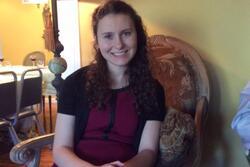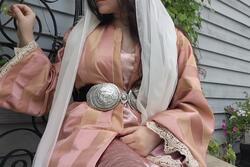Writing My Jewish Magical Realism
I’m a writer. I love to write. It’s what I take pride in, what I do in my free time, and what I get excited about. I don’t do it for other people, who may or may not read it. I do it for me, because it brings me joy. In every author's work, their life, culture, and thoughts are apparent in the words that they spell out. For me, my writing is young and in its beginning stages, but you can still see what influences it. I find great inspiration from the literary traditions of both magical realism and the Torah. Both are deeply ingrained in my soul, as they’re part of the air that I breathe and the life that I live. As a Sephardic Jew, I have two literary traditions to pull from: the multilayered harsh and soft ancient Hebrew letters that spell out my religious history, and the intricate, magical, literature that belongs to my ethnicity.
Magical realism is often associated with Latinos. To us (those of Hispanic descent), it’s not simply literature—it tells the story of our culture and history. In the thousands of stories that make up the genre, you can see the native Aztec, Incan, Mayan, and Olmec cultures from which magical elements derived. You can see this in the large amount of nature, regionalism, and spirituality ingrained in the genre, all of which are aspects of native Mexican culture. From a magical realism standpoint, fantastical elements don’t just belong in the world of fiction, but rather occur in real life all the time. There are the potions and appointment recipes that have been handed from generation to generation, said to cure anything from coughs to illnesses. Or perhaps stories of old family members showing up to a family gathering as spirits. To me, magical realism is a way of life, not just words on a page or elements of a plot. It's in my lineage, what I learned from bedtime stories, and how my community tells stories of our lives. It’s in our breath as we breathe words in everyday life. It’s woven into our tongues by our parents and by our parents’ parents. These descriptions parallel another literature style important to me, as it’s also the way I’d explain my connection to the Torah.
Similar to magical realism, the Torah is ingrained in my life. I went to Hebrew school as a young child and studied the interpretations of the great sages, and even came up with my own. The Torah connects Jews to our ancestors and to those around us. I have the ability to say that I’ve studied the same texts as millions of those who’ve come before me. I take part in traditions that have been around for thousands of years. This creates a strong sense of pride for me, due to the fact that I do not have close relations to my extended family, given language barriers and location barriers. Yet I am always reminded by Jewish texts that I am connected to a greater family: the Jewish people. While reading these ancient texts I am reminded that even throughout years of trials and tribulations we have made it out strong and cohesive, and that is something to be proud of.
Along with Torah come countless midrashim. One aspect I’ve found common among midrashim and other stories, including those in the Torah itself, is how the authors describe time. The texts tend to add copious detail, unlike the classic fairytale, which relies on broad terms like “once upon a time” or “long, long ago.” For example, in the story of Esther, the Torah specifically states that the story takes place in the third year of King Ahasuerus’s rule. There are also many numbers, like the number of days King Ahasuerus’s party was (180), or how the length of the banquet at the end of the party was exactly seven days. A story is incomplete without understanding the political and social context that impacts a character's decisions and reactions. The story of Esther would be incomplete if we didn’t know that this was King Ahasuerus’s third year as king, and thus he was young to ruling and more likely to make poor decisions from his lack of experience. It would be incomplete if we didn’t know that the party was 180 days, thus showing the king’s tendency towards extravagance and frivolousness. Jews have used these details for interpretation for generations, thanks to the intense capacity of our ancient texts. This aspect of Torah has taught me that in fiction, it’s important to provide context that can be used by the reader to draw historical parallels and reach deeper understandings.
My study of the Torah has influenced my writing in how I discuss the setting of my stories. When I describe a location in my fiction pieces, I focus on the land that the story takes place in. I tell its history as best I can, as the Torah has taught me that the land itself breathes with the events of its past. And magical realism supports this with its strong focus on nature and regionalism, a focus on a small region rather than a whole area. These focuses come from indigenous influences which center on their tribes and land. This is not much different for the tribe of Israel, who focus on similar aspects in the Torah.
My study of magical realism allows me to see the magic that exists in the world, which in turn leads me to write appreciatively and beautifully about the ordinary. Magical realism weaves in seemingly surreal elements into a topic that is on the surface tangible. This adds depth and facets to a realistic narrative. Since I have been raised from a young age to see this magic, my mind is supple to things that may seem hard to believe. As a writer, my imagination is a strong tool. It allows for more flexibility to add storylines and plots that may require more imagination for those who have not grown up with a constant reminder of spirits, and superstitions that are so prevalent in Latin culture.
My two identities and their literary traditions, Torah and magical realism, work together to shape my writing style. It’s apparent that the way I’ve grown up, and both my religious and ethnic backgrounds, have a great effect on how I write and what it is that I write about. I hope to continue weaving both influences into my future works, as a Sephardic Jew it is my job to carry the stories, traditions, and writing styles from one generation to the next, l’dor v’dor.
This piece was written as part of JWA’s Rising Voices Fellowship.








Insightful piece of work, Sofia!
Beautifully written Sofia!!